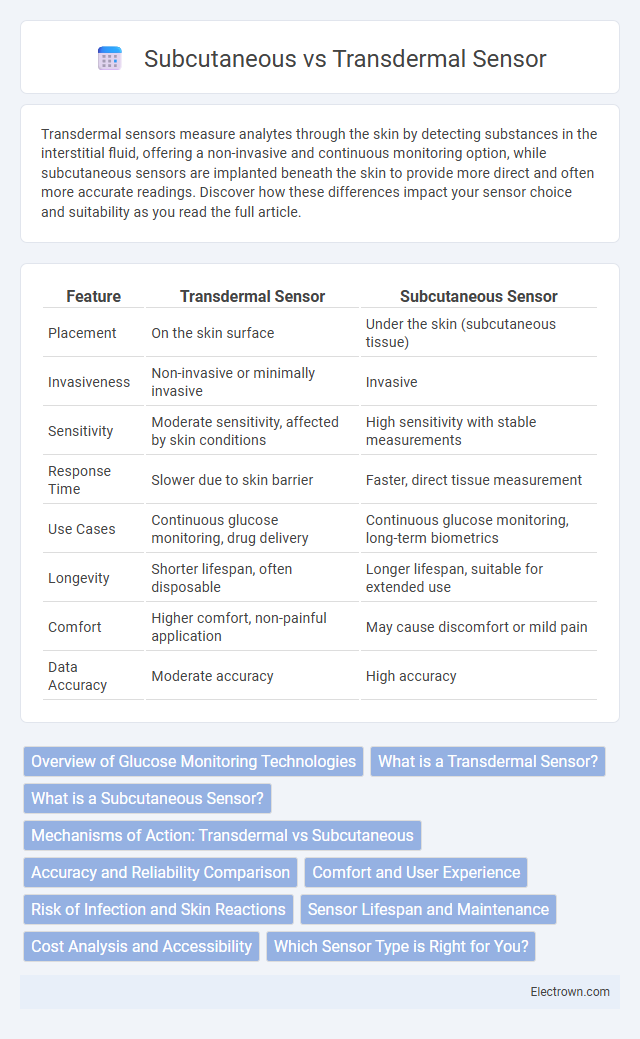Transdermal sensors measure analytes through the skin by detecting substances in the interstitial fluid, offering a non-invasive and continuous monitoring option, while subcutaneous sensors are implanted beneath the skin to provide more direct and often more accurate readings. Discover how these differences impact your sensor choice and suitability as you read the full article.
Table of Comparison
| Feature | Transdermal Sensor | Subcutaneous Sensor |
|---|---|---|
| Placement | On the skin surface | Under the skin (subcutaneous tissue) |
| Invasiveness | Non-invasive or minimally invasive | Invasive |
| Sensitivity | Moderate sensitivity, affected by skin conditions | High sensitivity with stable measurements |
| Response Time | Slower due to skin barrier | Faster, direct tissue measurement |
| Use Cases | Continuous glucose monitoring, drug delivery | Continuous glucose monitoring, long-term biometrics |
| Longevity | Shorter lifespan, often disposable | Longer lifespan, suitable for extended use |
| Comfort | Higher comfort, non-painful application | May cause discomfort or mild pain |
| Data Accuracy | Moderate accuracy | High accuracy |
Overview of Glucose Monitoring Technologies
Transdermal and subcutaneous glucose sensors both provide continuous glucose monitoring by measuring glucose levels through the skin, but they differ in their method of detection and accuracy. Subcutaneous sensors are implanted under the skin and measure interstitial glucose with higher precision, making them widely used in diabetes management for real-time data. You can choose the appropriate technology based on factors such as comfort, ease of use, and the accuracy required for effective glucose monitoring.
What is a Transdermal Sensor?
A transdermal sensor is a non-invasive device designed to monitor physiological parameters by detecting analytes through the skin without penetrating it. It typically uses passive diffusion techniques or micro-needles to extract information on glucose, alcohol, or other biomarkers from interstitial fluid or sweat. This technology enables continuous, real-time monitoring with minimal discomfort compared to subcutaneous sensors that require implantation under the skin.
What is a Subcutaneous Sensor?
A subcutaneous sensor is a medical device implanted just beneath the skin to continuously monitor glucose levels or other biomarkers in interstitial fluid. Unlike transdermal sensors that measure through the skin surface, subcutaneous sensors offer more accurate and real-time data by accessing the interstitial fluid directly. This type of sensor is commonly used in continuous glucose monitoring systems for diabetes management.
Mechanisms of Action: Transdermal vs Subcutaneous
Transdermal sensors measure analytes through the skin by extracting biochemical markers from the interstitial fluid using iontophoresis or reverse iontophoresis, providing non-invasive monitoring. Subcutaneous sensors are implanted just beneath the skin to directly sample interstitial fluid, enabling continuous and real-time analyte detection with greater accuracy. Your choice between these sensors impacts the balance of comfort, invasiveness, and precision in continuous glucose or biomarker monitoring.
Accuracy and Reliability Comparison
Transdermal sensors measure glucose levels through the skin's surface, offering minimal invasiveness but sometimes facing challenges with accuracy due to skin permeability variations and external factors. Subcutaneous sensors are implanted beneath the skin, providing more consistent and reliable glucose readings by directly sampling interstitial fluid, which closely reflects blood glucose levels. Your choice between these sensors should consider the balance of accuracy and reliability needed for effective glucose monitoring and diabetes management.
Comfort and User Experience
Transdermal sensors offer enhanced comfort by minimizing skin irritation through non-invasive monitoring, making them ideal for prolonged wear and daily activities. Subcutaneous sensors, while providing accurate biometric data via implantation under the skin, may cause discomfort during insertion and require careful management to avoid infection. User experience favors transdermal options for ease of use and reduced maintenance, but subcutaneous sensors excel in continuous, precise data collection crucial for certain medical applications.
Risk of Infection and Skin Reactions
Transdermal sensors reduce the risk of infection by minimizing skin penetration compared to subcutaneous sensors, which involve inserting a device beneath the skin and may increase exposure to pathogens. Subcutaneous sensors carry a higher likelihood of skin reactions, including irritation, redness, or allergic responses due to prolonged device contact within deeper tissue layers. You should evaluate your sensitivity and infection risk when choosing between these sensor types for optimal safety and comfort.
Sensor Lifespan and Maintenance
Transdermal sensors typically offer longer lifespans, often lasting several days to a week, with minimal maintenance required, as they are designed to continuously monitor through the skin without frequent recalibration. Subcutaneous sensors, inserted under the skin, generally require more regular maintenance, including cleaning and sensor replacement every few days to prevent infection and ensure accurate readings. Your choice should consider how sensor lifespan and maintenance routines fit into your lifestyle for consistent and reliable glucose monitoring.
Cost Analysis and Accessibility
Transdermal sensors generally have a higher upfront cost due to advanced technology designed for non-invasive monitoring, while subcutaneous sensors tend to be more affordable but involve invasive insertion. Accessibility varies as transdermal sensors provide easier application and are user-friendly for frequent monitoring without professional assistance, whereas subcutaneous sensors may require trained personnel for accurate placement and maintenance. Your choice should consider budget constraints and ease of access to ensure optimal sensor use and cost-effectiveness.
Which Sensor Type is Right for You?
Transdermal sensors offer continuous glucose monitoring through the skin's surface, providing non-invasive data ideal for users seeking convenience and minimal discomfort. Subcutaneous sensors, inserted just below the skin, deliver more precise glucose readings with faster response times, suitable for individuals requiring accurate, real-time management of blood sugar levels. Choosing the right sensor depends on lifestyle preferences, accuracy needs, and sensitivity to invasiveness, with healthcare professionals recommending personalized options based on individual health goals.
Transdermal vs Subcutaneous Sensor Infographic

 electrown.com
electrown.com